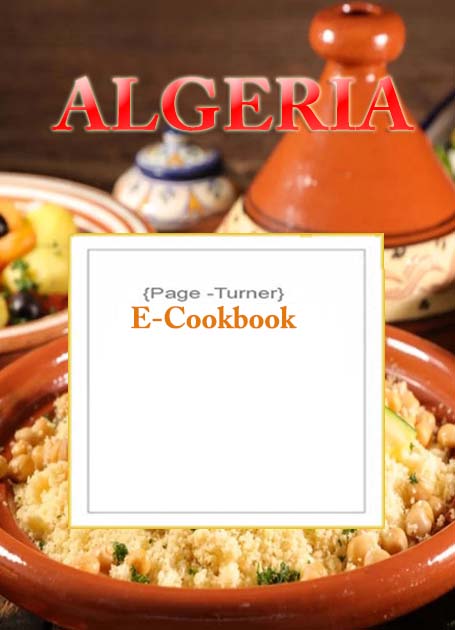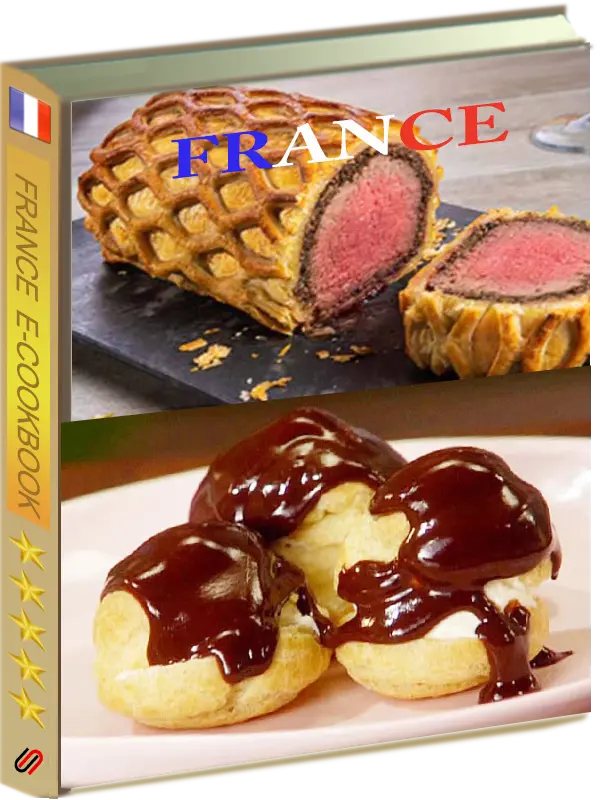algeria Is My Kitchen
ALGERIA Breakfast Appetizers & Soups
Desserts influenced by Mediterranean
Banana nut cake
Creamy lemon custards
Figs tart
Frozen orange soufflés
Honey lavender ice cream
Lemon yummy dessert
Millefeuille Prince Albert
Orange raisin cake
liquid Measures
Weight & temperature Measures
non-liquid ingredients
Top 5 countries
Last Page
Breakfast Appetizers Soups & salads influenced by Mediterranean
Asparagus and spinach salad
Banana nut cake
Bruschetta orzo salad
Butternut squash and caramelized onion flatbread
Crispy kale chips
Eggplant papeton
Eggplant-walnut paté
Goat cheese and sun-dried tomato toasts
ALGERIA Main Dishes
Berkoukech soup
Chicken couscous
Chicken salad
Moroccan spiced chickpea soup
Main Dishes influenced by Mediterranean Asparagus and spinach salad Banana nut cake Bruschetta orzo salad Butternut squash and caramelized onion flatbread Crispy kale chips Eggplant papeton Eggplant-walnut paté Goat cheese and sun-dried tomato toasts Lemony garlic butter bean dip Mediterranean egg sandwiches
Chicken couscous
Chicken salad
Moroccan spiced chickpea soup
Main Dishes influenced by Mediterranean Asparagus and spinach salad Banana nut cake Bruschetta orzo salad Butternut squash and caramelized onion flatbread Crispy kale chips Eggplant papeton Eggplant-walnut paté Goat cheese and sun-dried tomato toasts Lemony garlic butter bean dip Mediterranean egg sandwiches
Side Dishes influenced by Mediterranean
Asparagus and spinach salad
Chickpea salad
Gratin of swiss chard
Italian Celery hearts
Oven dried tomato and black olive tians
Potato eggplant tart
Ratatouille
Roasted asparagus
Weight & temperature Measures
non-liquid ingredients
Top 5 countries
Last Page
Traditional Algerian cuisine, a colorful combination of Berber, Turkish, French, and Arab tastes, can be either extremely mild or packed with flavorful seasonings. Ginger, saffron, onion, garlic, coriander, cumin, cinnamon, parsley, and mint are essential in any Algerian pantry.
Couscous , the national dish, is often mistaken as a grain itself, rather than pasta. The pasta dough is a mixture of water and coarse, grainy semolina wheat particles. The dough is then crumbled through a sieve to create tiny pellets. Algerians prefer lamb, chicken, or fish to be placed on a bed of warm couscous, along with cooked vegetables such as carrots, chickpeas, and tomatoes, and spicy stews. Couscous can also be used in desserts by adding a variety of ingredients, such as cinnamon, nutmeg, dates, and figs.
No Algerian meal would be complete without bread, normally a long, French loaf. Similar to Middle Eastern customs, bread is often used to scoop food off of a plate or to soak up a spicy sauce or stew. More traditional Berber families usually eat flat, wheat bread.
Mechoui , a roasted whole lamb cooked on an outdoor spit, is usually prepared when a large group of people gathers together. The animal is seasoned with herb butter so the skin is crispy and the meat inside is tender and juicy. Bread and various dried fruits and vegetables, including dates (whose trees can thrive in the country's Sahara desert), often accompany mechoui .
Couscous , the national dish, is often mistaken as a grain itself, rather than pasta. The pasta dough is a mixture of water and coarse, grainy semolina wheat particles. The dough is then crumbled through a sieve to create tiny pellets. Algerians prefer lamb, chicken, or fish to be placed on a bed of warm couscous, along with cooked vegetables such as carrots, chickpeas, and tomatoes, and spicy stews. Couscous can also be used in desserts by adding a variety of ingredients, such as cinnamon, nutmeg, dates, and figs.
No Algerian meal would be complete without bread, normally a long, French loaf. Similar to Middle Eastern customs, bread is often used to scoop food off of a plate or to soak up a spicy sauce or stew. More traditional Berber families usually eat flat, wheat bread.
Mechoui , a roasted whole lamb cooked on an outdoor spit, is usually prepared when a large group of people gathers together. The animal is seasoned with herb butter so the skin is crispy and the meat inside is tender and juicy. Bread and various dried fruits and vegetables, including dates (whose trees can thrive in the country's Sahara desert), often accompany mechoui .
Appetizer Asparagus and spinach salad 
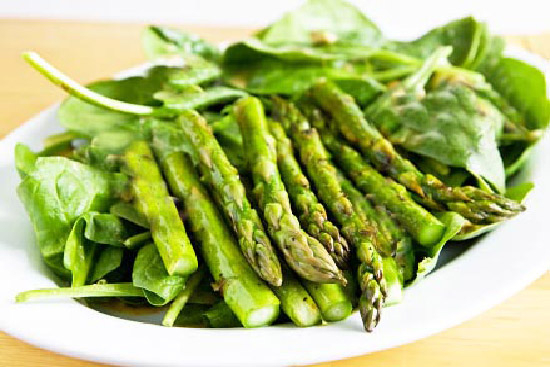
Serves: 4
Preparation time: 20 minutes
Cooking time:12 minutes
1/2 pound fresh asparagus 4 cups fresh spinach leaves
1 garlic clove, halved
8 slices baguette
For dressing:
1 tablespoon lemon juice
1 teaspoon Dijon mustard
2 tablespoons chicken stock
2 tablespoons canola oil
salt and pepper to taste
Clean and cut the tender part of asparagus into 2-inch pieces.
Boil for 5 minutes. Refresh under cold water.
Clean and spin dry spinach. Cut into bite size pieces.
Rub both sides of bread with garlic. Toast bread until golden. Cut into small squares.
Dressing:
In a medium bowl whisk the dressing ingredients together. Combine spinach and asparagus.
Toss with dressing. Sprinkle toasted bread over salad.
Boil for 5 minutes. Refresh under cold water.
Clean and spin dry spinach. Cut into bite size pieces.
Rub both sides of bread with garlic. Toast bread until golden. Cut into small squares.
Dressing:
In a medium bowl whisk the dressing ingredients together. Combine spinach and asparagus.
Toss with dressing. Sprinkle toasted bread over salad.
Appetizer Banana nut cake 
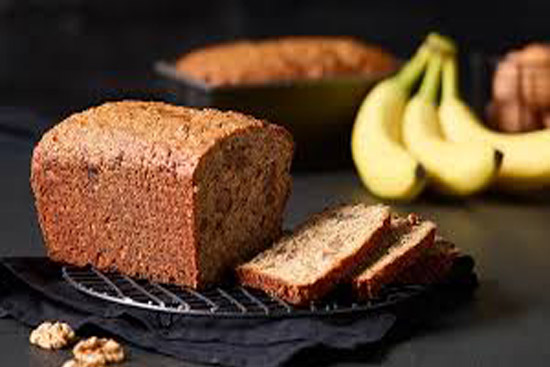
Serves: 12
Preparation time: 20 minutes
Cooking time:40 minutes
2 1/4 cups cake flour 1 2/3 cups sugar
1 1/2 teaspoons baking powder
1 1/2 teaspoons baking soda
1 teaspoon salt
2/3 cup shortening
2/3 cup buttermilk
3 eggs
1 1/4 cups banana, mashed
2/3 cup walnuts, chopped
Preheat oven to 350 degrees.
Grease and flour baking pans, one (13-inch by 9-inch by 2-inch) or two 9-inch, or 3 8-inch round layer pans.
Combine all ingredients in a mixing bowl. Beat 3 minutes scraping bowl occasionally.
Pour into pans. Bake 35 to 40 minutes.
If desired, frost with cream cheese frosting.
Grease and flour baking pans, one (13-inch by 9-inch by 2-inch) or two 9-inch, or 3 8-inch round layer pans.
Combine all ingredients in a mixing bowl. Beat 3 minutes scraping bowl occasionally.
Pour into pans. Bake 35 to 40 minutes.
If desired, frost with cream cheese frosting.
Appetizer Bruschetta orzo salad 

Serves: 2
Preparation time: 15 minutes
Cooking time:None
3/4 cup orzo, freshly cooked, rinsed and drained 2 medium Italian tomatoes, cored, seeded and chopped
2 tablespoons chopped black olives
1/2 cup red onion finely diced
1/3 cup fresh basil leaves, chopped
2 1/2 tablespoons balsamic vinegar
2 large garlic cloves, finely chopped
1 1/2 tablespoons olive oil
Combine all ingredients in bowl. Cover and chill at least 1 hour. Serve with toasted garlic bread
Appetizer Butternut squash and caramelized onion flatbread 

A wonderful recipe for a Fall or winter season showing the colors of this dish.
Prep and cook time are for flatbread only. If you're making the caramelized onions and butternut squash on the same day you're making the flatbread, allow about an extra hour.
Serves: 4
1 butternut squash cut into 1/2-inch chunks
2 tbsp olive oil
salt + pepper to taste
Caramelized Onions
2 tbsp olive oil
2 large onions halved & thinly sliced
salt + pepper to taste
1 prepared pizza crust
1/2 cup Fontina or Italian blend cheese shredded
2 tsp olive oil
2 tbsp sage leaves cut into ribbons
2 tbsp toasted walnuts chopped (optional)
Serves: 4
Preparation time:1 hour
Cooking time:1 hour
Roasted Butternut Squash1 butternut squash cut into 1/2-inch chunks
2 tbsp olive oil
salt + pepper to taste
Caramelized Onions
2 tbsp olive oil
2 large onions halved & thinly sliced
salt + pepper to taste
1 prepared pizza crust
1/2 cup Fontina or Italian blend cheese shredded
2 tsp olive oil
2 tbsp sage leaves cut into ribbons
2 tbsp toasted walnuts chopped (optional)
Roasted Butternut Squash
Preheat oven to 400°F.
Spread squash onto a rimmed baking sheet; drizzle sheet with 1 tablespoon of olive oil, sprinkle with salt and pepper and toss to coat.
Bake for 45–50 minutes or until tender.
Caramelized Onions
Heat oil in a large skillet over low heat.
Add onions and a pinch of salt. Cook until completely caramelized, stirring occasionally at first and more often as onions begin to brown, about 30 to 40 minutes.
Season with freshly ground pepper.
Preheat oven to temperature indicated on pizza crust package.
Top crust with caramelized onions, cheese, and squash.
Bake for time on package or until squash is heated through and cheese has melted.
While pizza is baking, heat oil in small skillet over medium high heat. Add sage leaves and saute, stirring constantly, for about 3 minutes or until leaves are crispy, but still green.
Sprinkle sage leaves and walnuts on pizza before serving.
Preheat oven to 400°F.
Spread squash onto a rimmed baking sheet; drizzle sheet with 1 tablespoon of olive oil, sprinkle with salt and pepper and toss to coat.
Bake for 45–50 minutes or until tender.
Caramelized Onions
Heat oil in a large skillet over low heat.
Add onions and a pinch of salt. Cook until completely caramelized, stirring occasionally at first and more often as onions begin to brown, about 30 to 40 minutes.
Season with freshly ground pepper.
Preheat oven to temperature indicated on pizza crust package.
Top crust with caramelized onions, cheese, and squash.
Bake for time on package or until squash is heated through and cheese has melted.
While pizza is baking, heat oil in small skillet over medium high heat. Add sage leaves and saute, stirring constantly, for about 3 minutes or until leaves are crispy, but still green.
Sprinkle sage leaves and walnuts on pizza before serving.
Appetizer Crispy kale chips 
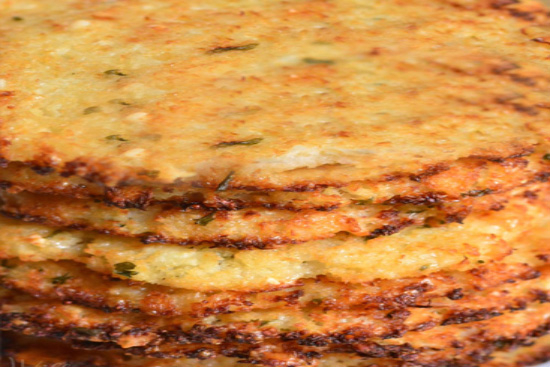
Serves: 4
Preparation time:10 minutes
Cooking time:30 minutes
1 head kale, washed and thoroughly dried2 tablespoons olive oil
Sea salt, for sprinkling
Preheat the oven to 275 degrees F.
Remove the ribs from the kale and cut into 1 1/2-inch pieces. Lay on a baking sheet.
Bake until crisp, turning the leaves halfway through, about 30 minutes.
Toss with the olive oil and salt.
Serve as finger food.
Remove the ribs from the kale and cut into 1 1/2-inch pieces. Lay on a baking sheet.
Bake until crisp, turning the leaves halfway through, about 30 minutes.
Toss with the olive oil and salt.
Serve as finger food.
Appetizer Eggplant papeton 
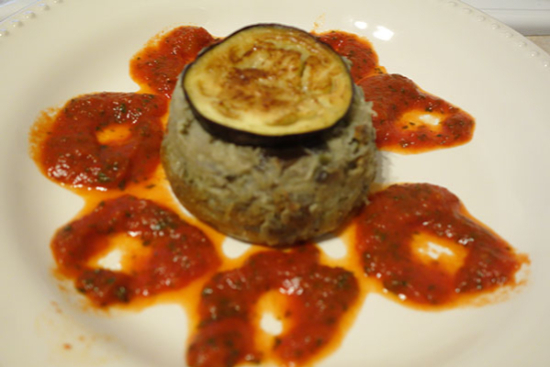
Papeton is a flan made with eggplant. The Provence specialty originated from Avignon.
Serves: 4
2 medium shallots, chopped
2 ounces olive oil
1 ounce butter
3 eggs, beaten
1/2 cup light cream
1 teaspoon cornstarch
1/2 teaspoon salt
1/4 teaspoon ground white pepper
1/4 teaspoon Aromat seasoning
1 cup light tomato sauce .
Serves: 4
Preparation time: 30 minutes
Cooking time:30 minutes
2 medium eggplants 2 medium shallots, chopped
2 ounces olive oil
1 ounce butter
3 eggs, beaten
1/2 cup light cream
1 teaspoon cornstarch
1/2 teaspoon salt
1/4 teaspoon ground white pepper
1/4 teaspoon Aromat seasoning
1 cup light tomato sauce .
Preheat oven at 350 degrees.
Peel eggplants. Cut into squares. Remove seeds.
Sauté shallots in oil and butter. Add eggplants. Cook for 10 minutes stirring occasionally to prevent sticking.
Puree mixture in food processor. Beat in eggs, cream, and cornstarch. Season well.
Pour into buttered oven proof individual dishes. Bake until mixture is firm.
Unmold on plates and serve with hot tomato sauce or marinara sauce
Peel eggplants. Cut into squares. Remove seeds.
Sauté shallots in oil and butter. Add eggplants. Cook for 10 minutes stirring occasionally to prevent sticking.
Puree mixture in food processor. Beat in eggs, cream, and cornstarch. Season well.
Pour into buttered oven proof individual dishes. Bake until mixture is firm.
Unmold on plates and serve with hot tomato sauce or marinara sauce
Appetizer Eggplant-walnut paté 
Serves: 4
Preparation time: 20 minutes
Cooking time:45 minutes
1 large eggplant 1 cup walnut pieces
2 teaspoons fresh gingerroot, peeled, grated, and finely chopped
2 cloves garlic, mashed
1 tablespoon extra-virgin olive oil
1/8 teaspoon ground allspice
salt and hot pepper sauce to taste
Preheat oven to 450°F.
Pierce the eggplant with a fork in several places and bake until very soft, about 45 minutes.
While the eggplant is baking, grind the walnuts in a food processor until very fine, and set aside.
Remove the eggplant from oven, slash to let steam escape, drain off any liquid, and scrape the pulp into a food processor with the gingerroot, garlic, and olive oil. Process until smooth. Add the ground walnuts and allspice, and process until smooth.
Season to taste with the salt, and hot pepper sauce. Spoon into a small loaf dish and chill several hours or until firm.
Pierce the eggplant with a fork in several places and bake until very soft, about 45 minutes.
While the eggplant is baking, grind the walnuts in a food processor until very fine, and set aside.
Remove the eggplant from oven, slash to let steam escape, drain off any liquid, and scrape the pulp into a food processor with the gingerroot, garlic, and olive oil. Process until smooth. Add the ground walnuts and allspice, and process until smooth.
Season to taste with the salt, and hot pepper sauce. Spoon into a small loaf dish and chill several hours or until firm.
Appetizer Goat cheese and sun-dried tomato toasts 

These simple, colorful little cheese toasts can be served as an appetizer or alongside a green salad.
Serves: 6
1 teaspoon cream
1 teaspoon fresh thyme, chopped
1teaspoon fresh rosemary, chopped
1/4 cup olive oil
12 long slices of baguette, cut diagonally about 1/4 inch thick
3 to 4 sun-dried tomatoes
freshly ground black pepper
Serves: 6
Preparation time: 15 minutes
Cooking time:10 minutes
5 ounces goat cheese 1 teaspoon cream
1 teaspoon fresh thyme, chopped
1teaspoon fresh rosemary, chopped
1/4 cup olive oil
12 long slices of baguette, cut diagonally about 1/4 inch thick
3 to 4 sun-dried tomatoes
freshly ground black pepper
Preheat the oven to 425 degrees. In a mixing bowl, combine the cheese and cream together.
Mix in half of the herbs and set it aside. Brush one side of the bread slices with olive oil, and toast them in the oven or under the broiler so that both sides are lightly colored.
Remove them from the oven and spread the cheese over the oiled sides. Drain the sun-dried tomatoes, and slice into narrow strips.
Lay the strips of tomato in a crisscross or diagonal pattern over the top and return the bread to the oven.
Bake until the cheese is warm and soft, about 3 minutes. Garnish with the remaining herbs and a grinding of black pepper over the top.
Mix in half of the herbs and set it aside. Brush one side of the bread slices with olive oil, and toast them in the oven or under the broiler so that both sides are lightly colored.
Remove them from the oven and spread the cheese over the oiled sides. Drain the sun-dried tomatoes, and slice into narrow strips.
Lay the strips of tomato in a crisscross or diagonal pattern over the top and return the bread to the oven.
Bake until the cheese is warm and soft, about 3 minutes. Garnish with the remaining herbs and a grinding of black pepper over the top.
Main Berkoukech soup 
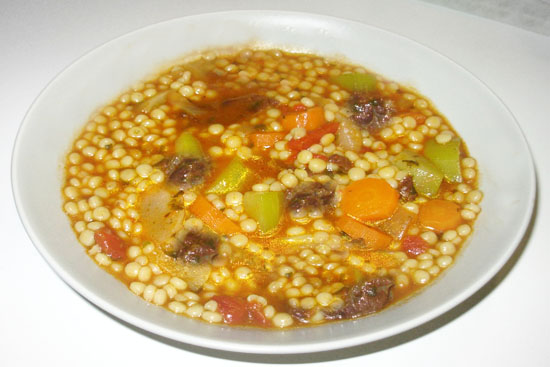
The name of this soup refers to a specific type of couscous called berkoukes. Israeli or pearl couscous are good substitutes.
Berkoukes soup is found in North Africa and in the Middle East.
Serves: 6
1 large onion, chopped
1/2 lb boneless chicken, beef or lamb, trimmed of excess fat and cut into 1-inch pieces
2 medium tomatoes, chopped
1 tsp tomato paste
1 tsp paprika
1/2 tsp ground coriander
1/2 tsp ground ginger
3 cloves garlic, minced
2 carrots, diced
2 celery stalks, diced
1 can chickpeas, drained
2 small zucchini, diced
2/3 cup uncooked Israeli couscous
Salt and pepper, to taste
Chopped cilantro, to serve
Serves: 6
Preparation time:20 minutes
Cooking time:90 minutes
1 tbsp olive oil1 large onion, chopped
1/2 lb boneless chicken, beef or lamb, trimmed of excess fat and cut into 1-inch pieces
2 medium tomatoes, chopped
1 tsp tomato paste
1 tsp paprika
1/2 tsp ground coriander
1/2 tsp ground ginger
3 cloves garlic, minced
2 carrots, diced
2 celery stalks, diced
1 can chickpeas, drained
2 small zucchini, diced
2/3 cup uncooked Israeli couscous
Salt and pepper, to taste
Chopped cilantro, to serve
1. In a large pot or Dutch oven, heat oil over medium heat. Add onions and sauté until translucent. Add meat, tomatoes, tomato paste, paprika, coriander, ginger and garlic. Season with salt and pepper and cook for 5-10 minutes, stirring occasionally, until meat is lightly browned.
2. Add carrots and celery. Add 5 cups of water. Bring to a boil, reduce to a simmer, and cook, covered, for about one hour, until meat is cooked and beginning to become tender.
3. Add the chickpeas and zucchini. Cook for 20 minutes more, until zucchini is softened.
4. If you plan to serve the soup right away, add the couscous directly to the pot and cook according to package directions. If you prepare the soup ahead of time, save this step until just before serving, as the couscous will continue to absorb liquid.
5. Garnish with chopped cilantro and serve.
2. Add carrots and celery. Add 5 cups of water. Bring to a boil, reduce to a simmer, and cook, covered, for about one hour, until meat is cooked and beginning to become tender.
3. Add the chickpeas and zucchini. Cook for 20 minutes more, until zucchini is softened.
4. If you plan to serve the soup right away, add the couscous directly to the pot and cook according to package directions. If you prepare the soup ahead of time, save this step until just before serving, as the couscous will continue to absorb liquid.
5. Garnish with chopped cilantro and serve.
Main Chicken couscous 

The Chicken Couscous is a flavorful and healthy dish with exotic spices but still simple enough to make any day of the week.
Pearl couscous, sometimes also called Israeli couscous is the same as regular couscous but just a bit bigger and sometimes comes in various colors.
Serves: 8
4 chicken breasts about 1 1/2 lbs, boneless and skinless
2 tablespoon olive oil
1 large onion chopped
5 cloves garlic minced
1/2 cup golden raisins
14 ounce chickpeas (1 can) drained and washed
14 ounce fire roasted tomatoes (1 can)
3 cups chicken broth low sodium
1 cup pearl couscous dry
4 cups kale rinsed and roughly chopped
Moroccan Spice Blend
1 teaspoon ground cumin
1 teaspoon ground cinnamon
1 teaspoon ground ginger
1 teaspoon salt
1/2 teaspoon black pepper
1 teaspoon paprika
1/2 teaspoon allspice
1 teaspoon coriander
1/2 teaspoon turmeric
1/4 teaspoon cayenne pepper
1 teaspoon cardamom
Serves: 8
Preparation time:20 minutes
Cooking time:1 hour 30 minutes
3 tablespoon Moroccan spice blend recipe below4 chicken breasts about 1 1/2 lbs, boneless and skinless
2 tablespoon olive oil
1 large onion chopped
5 cloves garlic minced
1/2 cup golden raisins
14 ounce chickpeas (1 can) drained and washed
14 ounce fire roasted tomatoes (1 can)
3 cups chicken broth low sodium
1 cup pearl couscous dry
4 cups kale rinsed and roughly chopped
Moroccan Spice Blend
1 teaspoon ground cumin
1 teaspoon ground cinnamon
1 teaspoon ground ginger
1 teaspoon salt
1/2 teaspoon black pepper
1 teaspoon paprika
1/2 teaspoon allspice
1 teaspoon coriander
1/2 teaspoon turmeric
1/4 teaspoon cayenne pepper
1 teaspoon cardamom
Preheat oven to 375 F degrees.
Combine all the Moroccan spice blend ingredients together. The recipe should yields about about 3 tbsp.
Season the chicken breasts with 2 tbsp of the Moroccan spice blend thoroughly. Use more as preferred.
In a large Dutch Oven or a oven safe pot, heat the olive oil over medium-high heat. When the oil is hot add the chicken breasts and sear on both sides until browned, about 2 to 3 minutes per side.
The chicken will not be cooked through at all, it will just be crispy on the outside. Transfer the chicken from the pot to a plate and set aside.
Add the onion and garlic to the pot and saute for about 3 minutes until onion softens and becomes translucent and garlic is aromatic. add the remaining 1 tbsp of the Moroccan spice blend and stir.
Add the golden raisins, chickpeas, fire roasted tomatoes, chicken broth, couscous and stir well. Gently stir in the kale. Bring to a boil, then add the chicken breasts back.
Cover the pot with a lid and place in the oven. Cook in the oven for 30 minutes with the lid on, then remove the lid and cook for an additional 30 minutes.
Combine all the Moroccan spice blend ingredients together. The recipe should yields about about 3 tbsp.
Season the chicken breasts with 2 tbsp of the Moroccan spice blend thoroughly. Use more as preferred.
In a large Dutch Oven or a oven safe pot, heat the olive oil over medium-high heat. When the oil is hot add the chicken breasts and sear on both sides until browned, about 2 to 3 minutes per side.
The chicken will not be cooked through at all, it will just be crispy on the outside. Transfer the chicken from the pot to a plate and set aside.
Add the onion and garlic to the pot and saute for about 3 minutes until onion softens and becomes translucent and garlic is aromatic. add the remaining 1 tbsp of the Moroccan spice blend and stir.
Add the golden raisins, chickpeas, fire roasted tomatoes, chicken broth, couscous and stir well. Gently stir in the kale. Bring to a boil, then add the chicken breasts back.
Cover the pot with a lid and place in the oven. Cook in the oven for 30 minutes with the lid on, then remove the lid and cook for an additional 30 minutes.
Main Chicken salad 

Serves: 4
Preparation time: 15 minutes
Cooking time:None
12 ounces cooked chicken 4 ounces diced celery
20 pieces pecans
1 diced shallot
2 hard cooked eggs, chopped
1 teaspoon lemon juice
1/2 cup mayonnaise
salt and white pepper to taste
8 leaves lettuce
Dice chicken. Combine with celery, nuts, shallots,chopped hard cooked eggs, and lemon juice.
Fold in mayonnaise and season with salt and pepper. Serve on lettuce leaf.
Fold in mayonnaise and season with salt and pepper. Serve on lettuce leaf.
Main Moroccan spiced chickpea soup 

Serves: 6
Preparation time: 10 minutes
Cooking time:1 hour
1/4 cup extra-virgin olive oil, plus more for garnish1 large onion, medium diced
6 to 8 cloves garlic, pressed
1 teaspoon ground cinnamon
1 teaspoon ground cumin
1/8 teaspoon cayenne pepper
1 heaping teaspoon sweet paprika
1 (14.5-ounce) can chopped tomatoes
3 (15-ounce) cans chickpeas, drained and rinsed well
1 quart vegetable broth or reduced-sodium chicken broth
1 teaspoon sugar
Kosher salt
Freshly ground black pepper
1 (5-ounce) package pre-washed baby spinach
Heat olive oil in a large pot over medium-high heat. Add onion and garlic and saute until the onions begin to turn translucent; lower heat if browning starts to occur. Add spices and saute a minute or so. Add tomatoes, chickpeas, broth, and sugar. Season with a couple pinches of salt and 10 grinds fresh pepper. Stir well. Chickpeas should be just covered with liquid. If level is shy, add some water so the chickpeas are just covered.
Bring to a simmer, then lower heat to low and gently simmer for 45 minutes.
Remove soup from heat. Use a potato masher to mash up some of the chickpeas right in the pot. Stir in the spinach and let heat through until wilted, just a couple minutes.
Season again, to taste, with salt and pepper.
Serve soup, drizzled lightly with extra-virgin olive oil, if desired.
Bring to a simmer, then lower heat to low and gently simmer for 45 minutes.
Remove soup from heat. Use a potato masher to mash up some of the chickpeas right in the pot. Stir in the spinach and let heat through until wilted, just a couple minutes.
Season again, to taste, with salt and pepper.
Serve soup, drizzled lightly with extra-virgin olive oil, if desired.
Main Asparagus and spinach salad 

Serves: 4
Preparation time: 20 minutes
Cooking time:12 minutes
1/2 pound fresh asparagus 4 cups fresh spinach leaves
1 garlic clove, halved
8 slices baguette
For dressing:
1 tablespoon lemon juice
1 teaspoon Dijon mustard
2 tablespoons chicken stock
2 tablespoons canola oil
salt and pepper to taste
Clean and cut the tender part of asparagus into 2-inch pieces.
Boil for 5 minutes. Refresh under cold water.
Clean and spin dry spinach. Cut into bite size pieces.
Rub both sides of bread with garlic. Toast bread until golden. Cut into small squares.
Dressing:
In a medium bowl whisk the dressing ingredients together. Combine spinach and asparagus.
Toss with dressing. Sprinkle toasted bread over salad.
Boil for 5 minutes. Refresh under cold water.
Clean and spin dry spinach. Cut into bite size pieces.
Rub both sides of bread with garlic. Toast bread until golden. Cut into small squares.
Dressing:
In a medium bowl whisk the dressing ingredients together. Combine spinach and asparagus.
Toss with dressing. Sprinkle toasted bread over salad.
Main Banana nut cake 

Serves: 12
Preparation time: 20 minutes
Cooking time:40 minutes
2 1/4 cups cake flour 1 2/3 cups sugar
1 1/2 teaspoons baking powder
1 1/2 teaspoons baking soda
1 teaspoon salt
2/3 cup shortening
2/3 cup buttermilk
3 eggs
1 1/4 cups banana, mashed
2/3 cup walnuts, chopped
Preheat oven to 350 degrees.
Grease and flour baking pans, one (13-inch by 9-inch by 2-inch) or two 9-inch, or 3 8-inch round layer pans.
Combine all ingredients in a mixing bowl. Beat 3 minutes scraping bowl occasionally.
Pour into pans. Bake 35 to 40 minutes.
If desired, frost with cream cheese frosting.
Grease and flour baking pans, one (13-inch by 9-inch by 2-inch) or two 9-inch, or 3 8-inch round layer pans.
Combine all ingredients in a mixing bowl. Beat 3 minutes scraping bowl occasionally.
Pour into pans. Bake 35 to 40 minutes.
If desired, frost with cream cheese frosting.
Main Bruschetta orzo salad 

Serves: 2
Preparation time: 15 minutes
Cooking time:None
3/4 cup orzo, freshly cooked, rinsed and drained 2 medium Italian tomatoes, cored, seeded and chopped
2 tablespoons chopped black olives
1/2 cup red onion finely diced
1/3 cup fresh basil leaves, chopped
2 1/2 tablespoons balsamic vinegar
2 large garlic cloves, finely chopped
1 1/2 tablespoons olive oil
Combine all ingredients in bowl. Cover and chill at least 1 hour. Serve with toasted garlic bread
Main Butternut squash and caramelized onion flatbread 

A wonderful recipe for a Fall or winter season showing the colors of this dish.
Prep and cook time are for flatbread only. If you're making the caramelized onions and butternut squash on the same day you're making the flatbread, allow about an extra hour.
Serves: 4
1 butternut squash cut into 1/2-inch chunks
2 tbsp olive oil
salt + pepper to taste
Caramelized Onions
2 tbsp olive oil
2 large onions halved & thinly sliced
salt + pepper to taste
1 prepared pizza crust
1/2 cup Fontina or Italian blend cheese shredded
2 tsp olive oil
2 tbsp sage leaves cut into ribbons
2 tbsp toasted walnuts chopped (optional)
Serves: 4
Preparation time:1 hour
Cooking time:1 hour
Roasted Butternut Squash1 butternut squash cut into 1/2-inch chunks
2 tbsp olive oil
salt + pepper to taste
Caramelized Onions
2 tbsp olive oil
2 large onions halved & thinly sliced
salt + pepper to taste
1 prepared pizza crust
1/2 cup Fontina or Italian blend cheese shredded
2 tsp olive oil
2 tbsp sage leaves cut into ribbons
2 tbsp toasted walnuts chopped (optional)
Roasted Butternut Squash
Preheat oven to 400°F.
Spread squash onto a rimmed baking sheet; drizzle sheet with 1 tablespoon of olive oil, sprinkle with salt and pepper and toss to coat.
Bake for 45–50 minutes or until tender.
Caramelized Onions
Heat oil in a large skillet over low heat.
Add onions and a pinch of salt. Cook until completely caramelized, stirring occasionally at first and more often as onions begin to brown, about 30 to 40 minutes.
Season with freshly ground pepper.
Preheat oven to temperature indicated on pizza crust package.
Top crust with caramelized onions, cheese, and squash.
Bake for time on package or until squash is heated through and cheese has melted.
While pizza is baking, heat oil in small skillet over medium high heat. Add sage leaves and saute, stirring constantly, for about 3 minutes or until leaves are crispy, but still green.
Sprinkle sage leaves and walnuts on pizza before serving.
Preheat oven to 400°F.
Spread squash onto a rimmed baking sheet; drizzle sheet with 1 tablespoon of olive oil, sprinkle with salt and pepper and toss to coat.
Bake for 45–50 minutes or until tender.
Caramelized Onions
Heat oil in a large skillet over low heat.
Add onions and a pinch of salt. Cook until completely caramelized, stirring occasionally at first and more often as onions begin to brown, about 30 to 40 minutes.
Season with freshly ground pepper.
Preheat oven to temperature indicated on pizza crust package.
Top crust with caramelized onions, cheese, and squash.
Bake for time on package or until squash is heated through and cheese has melted.
While pizza is baking, heat oil in small skillet over medium high heat. Add sage leaves and saute, stirring constantly, for about 3 minutes or until leaves are crispy, but still green.
Sprinkle sage leaves and walnuts on pizza before serving.
Main Crispy kale chips 

Serves: 4
Preparation time:10 minutes
Cooking time:30 minutes
1 head kale, washed and thoroughly dried2 tablespoons olive oil
Sea salt, for sprinkling
Preheat the oven to 275 degrees F.
Remove the ribs from the kale and cut into 1 1/2-inch pieces. Lay on a baking sheet.
Bake until crisp, turning the leaves halfway through, about 30 minutes.
Toss with the olive oil and salt.
Serve as finger food.
Remove the ribs from the kale and cut into 1 1/2-inch pieces. Lay on a baking sheet.
Bake until crisp, turning the leaves halfway through, about 30 minutes.
Toss with the olive oil and salt.
Serve as finger food.
Main Eggplant papeton 

Papeton is a flan made with eggplant. The Provence specialty originated from Avignon.
Serves: 4
2 medium shallots, chopped
2 ounces olive oil
1 ounce butter
3 eggs, beaten
1/2 cup light cream
1 teaspoon cornstarch
1/2 teaspoon salt
1/4 teaspoon ground white pepper
1/4 teaspoon Aromat seasoning
1 cup light tomato sauce .
Serves: 4
Preparation time: 30 minutes
Cooking time:30 minutes
2 medium eggplants 2 medium shallots, chopped
2 ounces olive oil
1 ounce butter
3 eggs, beaten
1/2 cup light cream
1 teaspoon cornstarch
1/2 teaspoon salt
1/4 teaspoon ground white pepper
1/4 teaspoon Aromat seasoning
1 cup light tomato sauce .
Preheat oven at 350 degrees.
Peel eggplants. Cut into squares. Remove seeds.
Sauté shallots in oil and butter. Add eggplants. Cook for 10 minutes stirring occasionally to prevent sticking.
Puree mixture in food processor. Beat in eggs, cream, and cornstarch. Season well.
Pour into buttered oven proof individual dishes. Bake until mixture is firm.
Unmold on plates and serve with hot tomato sauce or marinara sauce
Peel eggplants. Cut into squares. Remove seeds.
Sauté shallots in oil and butter. Add eggplants. Cook for 10 minutes stirring occasionally to prevent sticking.
Puree mixture in food processor. Beat in eggs, cream, and cornstarch. Season well.
Pour into buttered oven proof individual dishes. Bake until mixture is firm.
Unmold on plates and serve with hot tomato sauce or marinara sauce
Main Eggplant-walnut paté 
Serves: 4
Preparation time: 20 minutes
Cooking time:45 minutes
1 large eggplant 1 cup walnut pieces
2 teaspoons fresh gingerroot, peeled, grated, and finely chopped
2 cloves garlic, mashed
1 tablespoon extra-virgin olive oil
1/8 teaspoon ground allspice
salt and hot pepper sauce to taste
Preheat oven to 450°F.
Pierce the eggplant with a fork in several places and bake until very soft, about 45 minutes.
While the eggplant is baking, grind the walnuts in a food processor until very fine, and set aside.
Remove the eggplant from oven, slash to let steam escape, drain off any liquid, and scrape the pulp into a food processor with the gingerroot, garlic, and olive oil. Process until smooth. Add the ground walnuts and allspice, and process until smooth.
Season to taste with the salt, and hot pepper sauce. Spoon into a small loaf dish and chill several hours or until firm.
Pierce the eggplant with a fork in several places and bake until very soft, about 45 minutes.
While the eggplant is baking, grind the walnuts in a food processor until very fine, and set aside.
Remove the eggplant from oven, slash to let steam escape, drain off any liquid, and scrape the pulp into a food processor with the gingerroot, garlic, and olive oil. Process until smooth. Add the ground walnuts and allspice, and process until smooth.
Season to taste with the salt, and hot pepper sauce. Spoon into a small loaf dish and chill several hours or until firm.
Main Goat cheese and sun-dried tomato toasts 

These simple, colorful little cheese toasts can be served as an appetizer or alongside a green salad.
Serves: 6
1 teaspoon cream
1 teaspoon fresh thyme, chopped
1teaspoon fresh rosemary, chopped
1/4 cup olive oil
12 long slices of baguette, cut diagonally about 1/4 inch thick
3 to 4 sun-dried tomatoes
freshly ground black pepper
Serves: 6
Preparation time: 15 minutes
Cooking time:10 minutes
5 ounces goat cheese 1 teaspoon cream
1 teaspoon fresh thyme, chopped
1teaspoon fresh rosemary, chopped
1/4 cup olive oil
12 long slices of baguette, cut diagonally about 1/4 inch thick
3 to 4 sun-dried tomatoes
freshly ground black pepper
Preheat the oven to 425 degrees. In a mixing bowl, combine the cheese and cream together.
Mix in half of the herbs and set it aside. Brush one side of the bread slices with olive oil, and toast them in the oven or under the broiler so that both sides are lightly colored.
Remove them from the oven and spread the cheese over the oiled sides. Drain the sun-dried tomatoes, and slice into narrow strips.
Lay the strips of tomato in a crisscross or diagonal pattern over the top and return the bread to the oven.
Bake until the cheese is warm and soft, about 3 minutes. Garnish with the remaining herbs and a grinding of black pepper over the top.
Mix in half of the herbs and set it aside. Brush one side of the bread slices with olive oil, and toast them in the oven or under the broiler so that both sides are lightly colored.
Remove them from the oven and spread the cheese over the oiled sides. Drain the sun-dried tomatoes, and slice into narrow strips.
Lay the strips of tomato in a crisscross or diagonal pattern over the top and return the bread to the oven.
Bake until the cheese is warm and soft, about 3 minutes. Garnish with the remaining herbs and a grinding of black pepper over the top.
Main Lemony garlic butter bean dip 

This recipe will work best with creamy white varieties such as butter beans, cannellini beans (white kidney beans), haricot beans (navy beans), or Great Northern beans. You'll want to make sure these are canned or pre-cooked.
Butter beans are not only high in iron and a great source of fiber and protein, but they also have a wonderful creamy buttery texture when puréed. This dip takes no time to prepare and its light fresh taste makes for a perfect addition to your entertaining.
Serves: 6
¼ cup (60 mL) extra virgin olive oil
1 large garlic clove, roughly chopped
5 tbsp (75 mL) fresh lemon juice
½ tsp (2 mL) sea salt
½ tsp (2 mL) fresh ground pepper
GARNISH
1 tbsp (15 mL) extra virgin olive oil
½ tsp (2 mL) dried chilies
Zest of 1 lemon
Serves: 6
Preparation time:10 minutes
2 cans (each 398 mL) butter beans ¼ cup (60 mL) extra virgin olive oil
1 large garlic clove, roughly chopped
5 tbsp (75 mL) fresh lemon juice
½ tsp (2 mL) sea salt
½ tsp (2 mL) fresh ground pepper
GARNISH
1 tbsp (15 mL) extra virgin olive oil
½ tsp (2 mL) dried chilies
Zest of 1 lemon
1 Drain and rinse butter beans and place in food processor. Add remaining ingredients and process until smooth.
2 Place in serving bowl and garnish with olive oil, chilies and lemon zest. Serve alongside toast rounds or vegetable sticks
2 Place in serving bowl and garnish with olive oil, chilies and lemon zest. Serve alongside toast rounds or vegetable sticks
Main Mediterranean egg sandwiches 

Sandwich thins are bread rolls that are thinner and have fewer calories than standard sandwich rolls. We recommend using multigrain sandwich thins but feel free to use any variety of whole-grain sandwich thins. If you can't find sandwich thins, you can substitute them with multigrain English muffins.
Serves: 4
2 tablespoons olive oil
1 tablespoon snipped fresh rosemary or 1/2 teaspoon dried rosemary, crushed
4 eggs
2 cups fresh baby spinach leaves
1 medium tomato, cut into 8 thin slices
4 tablespoons feta cheese
⅛ teaspoon kosher salt
Freshly ground black pepper
Serves: 4
Preparation time:5 minutes
Cooking time:15 minutes
4 multigrain sandwich thins2 tablespoons olive oil
1 tablespoon snipped fresh rosemary or 1/2 teaspoon dried rosemary, crushed
4 eggs
2 cups fresh baby spinach leaves
1 medium tomato, cut into 8 thin slices
4 tablespoons feta cheese
⅛ teaspoon kosher salt
Freshly ground black pepper
Preheat oven to 375°F. Split sandwich thins; brush cut sides with 2 teaspoons of the olive oil. Place on rimmed baking sheet; toast in oven about 5 minutes or until edges are light brown and crisp.
Meanwhile, in a large skillet heat the remaining 2 teaspoons olive oil and the rosemary over medium-high heat. Break eggs, one at a time, into skillet. Cook about 1 minute or until whites are set but yolks are still runny. Break yolks with spatula. Flip eggs; cook on the other side until done. Remove from heat.
Steam the spinach for 5 minutes. Cool and drain well.
Place the bottom halves of the toasted sandwich thins on 4 serving plates. Divide spinach among sandwich thins on plates. Top each with 2 of the tomato slices, an egg and 1 tablespoon of the feta cheese. Sprinkle with the salt and pepper. Top with the remaining sandwich thin halves.
Meanwhile, in a large skillet heat the remaining 2 teaspoons olive oil and the rosemary over medium-high heat. Break eggs, one at a time, into skillet. Cook about 1 minute or until whites are set but yolks are still runny. Break yolks with spatula. Flip eggs; cook on the other side until done. Remove from heat.
Steam the spinach for 5 minutes. Cool and drain well.
Place the bottom halves of the toasted sandwich thins on 4 serving plates. Divide spinach among sandwich thins on plates. Top each with 2 of the tomato slices, an egg and 1 tablespoon of the feta cheese. Sprinkle with the salt and pepper. Top with the remaining sandwich thin halves.
other Side Dish Asparagus and spinach salad 

Serves: 4
Preparation time: 20 minutes
Cooking time:12 minutes
1/2 pound fresh asparagus 4 cups fresh spinach leaves
1 garlic clove, halved
8 slices baguette
For dressing:
1 tablespoon lemon juice
1 teaspoon Dijon mustard
2 tablespoons chicken stock
2 tablespoons canola oil
salt and pepper to taste
Clean and cut the tender part of asparagus into 2-inch pieces.
Boil for 5 minutes. Refresh under cold water.
Clean and spin dry spinach. Cut into bite size pieces.
Rub both sides of bread with garlic. Toast bread until golden. Cut into small squares.
Dressing:
In a medium bowl whisk the dressing ingredients together. Combine spinach and asparagus.
Toss with dressing. Sprinkle toasted bread over salad.
Boil for 5 minutes. Refresh under cold water.
Clean and spin dry spinach. Cut into bite size pieces.
Rub both sides of bread with garlic. Toast bread until golden. Cut into small squares.
Dressing:
In a medium bowl whisk the dressing ingredients together. Combine spinach and asparagus.
Toss with dressing. Sprinkle toasted bread over salad.
other Side Dish Chickpea salad 

Serves: 4
Preparation time:15 minutes
Cooking time:5 minutes
For the Chickpea Salad:1 (15-ounce) can chickpeas
1 tablespoon olive oil
1 pint cherry tomatoes, halved
1/2 red onion, sliced
1 yellow bell pepper, diced
1 orange bell pepper, diced
2 tablespoons chopped fresh parsley
1/2 cup crumbled feta cheese
For the Dressing:
1 clove garlic, finely minced or grated
1/4 cup extra-virgin olive oil
2 tablespoons fresh lemon juice
1 teaspoon mustard
1/2 teaspoon dried oregano
1/4 teaspoon freshly ground black pepper
1/4 teaspoon salt
Rinse and thoroughly drain the chickpeas. Add to a large skillet or cast iron pan along with the tablespoon of olive oil. Saute on medium high heat, stirring often, for about 5 minutes until the chickpeas are slightly crisped.
Make the dressing by whisking together the minced garlic, extra-virgin olive oil, fresh lemon juice, mustard, dried oregano, salt, and pepper in a serving bowl.
Add the chickpeas, cherry tomatoes, sliced red onions, diced orange and yellow bell peppers and parsley to the bowl and toss. Top with the crumbled feta cheese and serve at room temperature.
Make the dressing by whisking together the minced garlic, extra-virgin olive oil, fresh lemon juice, mustard, dried oregano, salt, and pepper in a serving bowl.
Add the chickpeas, cherry tomatoes, sliced red onions, diced orange and yellow bell peppers and parsley to the bowl and toss. Top with the crumbled feta cheese and serve at room temperature.
other Side Dish Gratin of swiss chard 
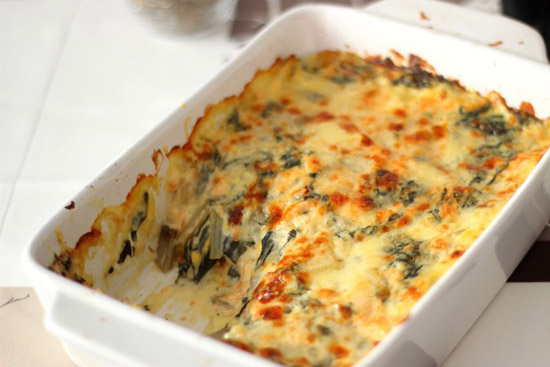
Serve this gratin as a first course, as a side dish with grilled chicken.
Serves: 5
450g/1lb ruby or Swiss chard, stems and broad ribs cut into 1cm/½in pieces, leaves finely sliced
salt and freshly ground black pepper
60g/2oz black olives, stones removed
2 canned anchovy fillets, chopped
2 sun-dried tomatoes, chopped
½ tbsp capers, rinsed and drained
1 tbsp chopped fresh parsley
60g/2oz gruyère cheese, grated
30g/1oz parmesan, freshly grated
Serves: 5
Preparation time:30 minutes
Cooking time:40 minutes
5 tbsp olive oil, plus extra for greasing450g/1lb ruby or Swiss chard, stems and broad ribs cut into 1cm/½in pieces, leaves finely sliced
salt and freshly ground black pepper
60g/2oz black olives, stones removed
2 canned anchovy fillets, chopped
2 sun-dried tomatoes, chopped
½ tbsp capers, rinsed and drained
1 tbsp chopped fresh parsley
60g/2oz gruyère cheese, grated
30g/1oz parmesan, freshly grated
Preheat the oven to 190C/375F/Gas 5.
Heat two tablespoons of the olive oil in a wide, lidded pan and add the chopped chard ribs. Stir, then cover and cook over a low heat for four minutes, stirring occasionally.
Add the leaves, stir, then cover again and cook for a further five minutes, or until just tender. Season with salt and freshly ground black pepper and set aside.
Place the olives, anchovies, sun-dried tomatoes, capers, parsley and two tablespoons of olive oil into a food processor and blend to make a smooth paste.
Lightly oil a 30cm/12in ovenproof dish. Place a layer of the chard, along with any cooking juices. Spread a little of the olive paste over the chard and season with freshly ground black pepper. Continue to layer up the chard, spreading more of the olive paste between each layer and finishing with a layer of chard.
Mix the gruyère and parmesan in a bowl and sprinkle over the top of the gratin. Drizzle over the remaining tablespoon of olive oil.
Transfer to the oven and bake for about 25-30 minutes, until the cheese is browned and bubbling. Serve hot or warm.
Heat two tablespoons of the olive oil in a wide, lidded pan and add the chopped chard ribs. Stir, then cover and cook over a low heat for four minutes, stirring occasionally.
Add the leaves, stir, then cover again and cook for a further five minutes, or until just tender. Season with salt and freshly ground black pepper and set aside.
Place the olives, anchovies, sun-dried tomatoes, capers, parsley and two tablespoons of olive oil into a food processor and blend to make a smooth paste.
Lightly oil a 30cm/12in ovenproof dish. Place a layer of the chard, along with any cooking juices. Spread a little of the olive paste over the chard and season with freshly ground black pepper. Continue to layer up the chard, spreading more of the olive paste between each layer and finishing with a layer of chard.
Mix the gruyère and parmesan in a bowl and sprinkle over the top of the gratin. Drizzle over the remaining tablespoon of olive oil.
Transfer to the oven and bake for about 25-30 minutes, until the cheese is browned and bubbling. Serve hot or warm.
other Side Dish Italian Celery hearts 
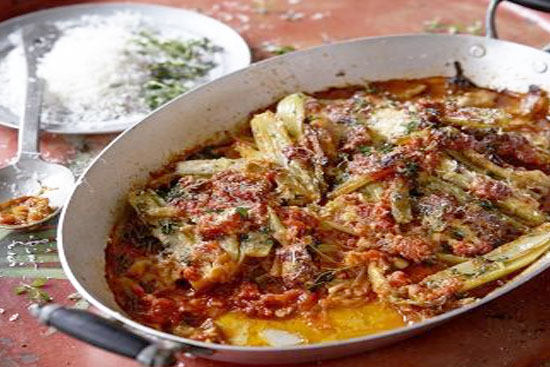
Serves: 6
Preparation time: 15 minutes
Cooking time:1 hour 15 minutes
4 celery hearts1 small onion
2 cloves of garlic
a few sprigs of fresh thyme
3 slices smoked pancetta or bacon
extra virgin olive oil
½ teaspoon fennel seeds
1 x 400 g can of chopped tomatoes
75 g Parmesan cheese
Preheat the oven to 180ºC/gas 4.
Trim the bases of the celery hearts and peel the outer stalks, keeping each heart in 1 piece. Trim the ends so the hearts are 12 to 15cm long. Cut the celery lengthways into quarters, then across in half.
Peel and slice the onion lengthways, and peel and finely chop the garlic. Pick and finely chop the thyme leaves, then chop the pancetta or bacon
Place a saucepan over a medium heat and add a splash of oil. Add the onion and pancetta or bacon, and cook for a few minutes until the onion is soft. Add the celery and cook with the lid on until the celery is soft.
Heat another pan and add a splash of oil. Add the garlic and fennel seeds, then, when the garlic’s golden brown, tip in the tomatoes. Fill the tomato tin with water and add that, along with a good pinch of sea salt and black pepper. Cook the sauce over a medium heat for half an hour or so, until reduced and thick.
When the celery’s soft, remove the lid and let the ingredients brown slightly on the bottom of the pan.
Lightly oil a shallow 20cm x 20cm baking dish and spoon a little tomato sauce in the bottom. Spread it out and top with about a third of the celery pieces. Cover with more tomato sauce, some thyme leaves and a good grating of Parmesan. Keep layering, then finish with the last of the tomato sauce, lots of cheese and a sprinkle of sea salt and black pepper.
Bake for about 20 minutes, or until heated through and crisp on top.
Trim the bases of the celery hearts and peel the outer stalks, keeping each heart in 1 piece. Trim the ends so the hearts are 12 to 15cm long. Cut the celery lengthways into quarters, then across in half.
Peel and slice the onion lengthways, and peel and finely chop the garlic. Pick and finely chop the thyme leaves, then chop the pancetta or bacon
Place a saucepan over a medium heat and add a splash of oil. Add the onion and pancetta or bacon, and cook for a few minutes until the onion is soft. Add the celery and cook with the lid on until the celery is soft.
Heat another pan and add a splash of oil. Add the garlic and fennel seeds, then, when the garlic’s golden brown, tip in the tomatoes. Fill the tomato tin with water and add that, along with a good pinch of sea salt and black pepper. Cook the sauce over a medium heat for half an hour or so, until reduced and thick.
When the celery’s soft, remove the lid and let the ingredients brown slightly on the bottom of the pan.
Lightly oil a shallow 20cm x 20cm baking dish and spoon a little tomato sauce in the bottom. Spread it out and top with about a third of the celery pieces. Cover with more tomato sauce, some thyme leaves and a good grating of Parmesan. Keep layering, then finish with the last of the tomato sauce, lots of cheese and a sprinkle of sea salt and black pepper.
Bake for about 20 minutes, or until heated through and crisp on top.
other Side Dish Oven dried tomato and black olive tians 
Serves: 6
Preparation time: 30 minutes
Cooking time:1 hour 30 minutes
12 ripe Italian tomatoes 4 tablespoons extra virgin olive oil
4 ounces Kalamata olives, pitted
1 tablespoon fresh thyme, minced
1 tablespoon wine vinegar
salt and freshly ground black pepper
Blanch the tomatoes in salted boiling water, remove, and shock in ice water. Peel the tomatoes and reserve the peel for the fried garnish.
Cut each tomato into four pieces and remove the inner seed core. Season the tomatoes with salt, pepper, and extra virgin olive oil.
Place the tomato slices on a rack, and bake for 1 hour in a 250 degree F oven.
Remove the tomatoes from the oven and cool. When the tomatoes are cool, finely dice them and place on paper towels to dry.
When drained, season the tomatoes with olive oil, salt, pepper and fresh thyme and wine vinegar.
In a food processor, add the Kalamata olives and puree to a paste. Remove and set aside.
Place a layer of the tomato mixture into a 1-inch round ring mold and pack down. Place a very thin layer of black olive paste into the mold and pack down. Repeat 10 times.
Finish with 1 more layer of tomato and pack down. Just before you are ready to serve, heat the tians through in a 300 degree F. oven.
Preheat a fryer to 300 degrees F. Blot the reserved tomato skins with paper towels to dry them of any moisture.
Place the skins in the oil and fry just until the water comes out and the skins are crisp and golden. Do not brown skins.
Remove from the molds onto plates and top with fried tomato skins.
Cut each tomato into four pieces and remove the inner seed core. Season the tomatoes with salt, pepper, and extra virgin olive oil.
Place the tomato slices on a rack, and bake for 1 hour in a 250 degree F oven.
Remove the tomatoes from the oven and cool. When the tomatoes are cool, finely dice them and place on paper towels to dry.
When drained, season the tomatoes with olive oil, salt, pepper and fresh thyme and wine vinegar.
In a food processor, add the Kalamata olives and puree to a paste. Remove and set aside.
Place a layer of the tomato mixture into a 1-inch round ring mold and pack down. Place a very thin layer of black olive paste into the mold and pack down. Repeat 10 times.
Finish with 1 more layer of tomato and pack down. Just before you are ready to serve, heat the tians through in a 300 degree F. oven.
Preheat a fryer to 300 degrees F. Blot the reserved tomato skins with paper towels to dry them of any moisture.
Place the skins in the oil and fry just until the water comes out and the skins are crisp and golden. Do not brown skins.
Remove from the molds onto plates and top with fried tomato skins.
other Side Dish Potato eggplant tart 
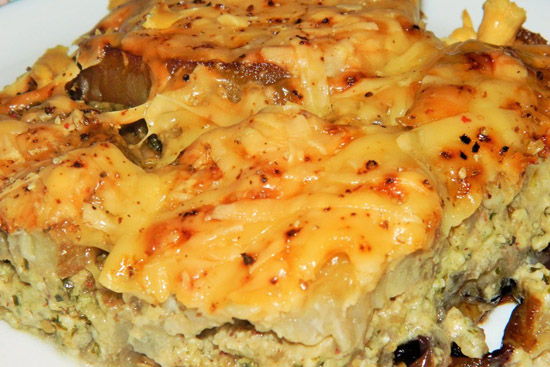
Serves: 8
Preparation time: 30 minutes
Cooking time:50 minutes
2 1/4 cups finely diced, peeled eggplant 1 tablespoon coarse salt plus more to taste
1/4 cup plus 2 tablespoons canola oil
3 tablespoons minced shallots
4 large Idaho potatoes
to taste pepper
1/4 cup butter
Place eggplant in non-reactive bowl. Toss with 1 teaspoon salt and set aside for 20 minutes. Remove to a clean kitchen towel and tightly twist to squeeze out all moisture. Heat 2 tablespoons of oil in sauté pan. Add eggplant and shallots and sauté until very tender. Remove from heat.
Peel potatoes. Using a mandoline, shred potatoes into a clean kitchen towel. Tightly squeeze out moisture.
Heat vegetables in 1/4 cup of oil in a 9-inch ovenproof, nonstick saute pan over medium heat. Using a spatula, evenly press half of the potatoes into the pan. Season with salt and pepper. Spread the reserved eggplant over the top. Pat remaining potatoes evenly over the eggplant. Again season to taste. Cook, until bottom is golden.
Carefully turn and dab the crust with bits of butter. Cook until bottom begins to crisp. Place in oven and bake until potatoes are cooked and tart is golden and crisp. Remove from oven and allow to rest 5 minutes. Using sharp serrated knife, cut into 6 wedges.
Peel potatoes. Using a mandoline, shred potatoes into a clean kitchen towel. Tightly squeeze out moisture.
Heat vegetables in 1/4 cup of oil in a 9-inch ovenproof, nonstick saute pan over medium heat. Using a spatula, evenly press half of the potatoes into the pan. Season with salt and pepper. Spread the reserved eggplant over the top. Pat remaining potatoes evenly over the eggplant. Again season to taste. Cook, until bottom is golden.
Carefully turn and dab the crust with bits of butter. Cook until bottom begins to crisp. Place in oven and bake until potatoes are cooked and tart is golden and crisp. Remove from oven and allow to rest 5 minutes. Using sharp serrated knife, cut into 6 wedges.
other Side Dish Ratatouille 
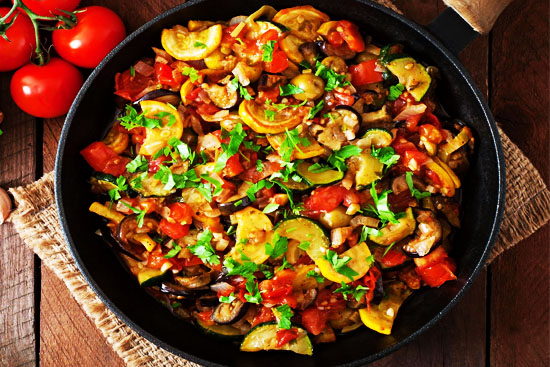
Recipe credited to The French Secret to Ratatouille, a Last Taste of Summer
By Bill Buford
Serves: 8
A good olive oil
A pinch of sugar
A pinch of saffron (optional)
4 medium-sized red bell peppers
3 large onions, peeled and roughly diced
3 medium-sized eggplants, peeled and roughly diced
2 cloves of garlic, peeled
Sprigs of rosemary and thyme, tied together into a bouquet garni, plus 1 tsp. of thyme leaves
A handful of basil leaves (optional)
3 medium-sized zucchini
1-3 Tbsp. red-wine vinegar, according to taste
A dozen pitted black Kalamata olives (optional)
Salt and pepper
Basil leaves
Serves: 8
Preparation time: 20 mnutes
Cooking time:1 hour 30 minutes
2 lbs. tomatoes, preferably fleshy plum tomatoes (rather than a juicy heritage breed)A good olive oil
A pinch of sugar
A pinch of saffron (optional)
4 medium-sized red bell peppers
3 large onions, peeled and roughly diced
3 medium-sized eggplants, peeled and roughly diced
2 cloves of garlic, peeled
Sprigs of rosemary and thyme, tied together into a bouquet garni, plus 1 tsp. of thyme leaves
A handful of basil leaves (optional)
3 medium-sized zucchini
1-3 Tbsp. red-wine vinegar, according to taste
A dozen pitted black Kalamata olives (optional)
Salt and pepper
Basil leaves
1. Prepare tomatoes. Heat oven to 225 degrees. Drop the tomatoes into a pot of boiling water, and, if necessary, weigh them down with a heavy slotted spoon, to keep them from floating. After 2–3 minutes, test by pulling off a bit of skin with a paring knife. If it comes off easily, pull tomatoes out, one by one, and drop them into the ice bath. After a minute or two, retrieve them and peel off the skin.
2. Place a sieve over an empty bowl. Cut the peeled tomatoes into quarters, then scoop out the seeds with a spoon and place them into the sieve. Set aside.
3. Line a sheet pan with parchment paper. Brush the paper with olive oil and season it lightly with salt and sugar. Place tomatoes on the paper cut-side down and brush them, too, with the oil. Cook for about 40 minutes, until they are cooked but still firm. Cool and set aside.
4. While tomatoes roast, stir the tomato pulp and seeds in the sieve vigorously with a spatula or wooden spoon, to extract the maximum possible liquid. You should have between ½ cup and 1 cup. Pour the liquid into a saucepan, place over low heat, and simmer, gently, until the volume is reduced by half. Set aside.
5. If you are using saffron, hydrate in water and set aside.
6. Prepare peppers. Raise the oven temperature to 425 and insert a medium-sized tray. When hot, remove the tray and splash with olive oil, then add peppers and, with a pair of tongs, roll them in the oil to cover. Return the tray to the oven. Check after ten minutes. If the peppers have begun to brown, flip them with the tongs. Check after another 10 minutes and repeat, until peppers are nearly black on all sides. Remove the tray from the oven and, if needed, wrap peppers in a piece of aluminum foil (the trapped steam helps loosen the skin). When peppers are cool enough to touch, peel off the skin with a paring knife. Remove the stems and seeds and cut peppers into quarters.
7. Prepare onion. Heat a sauté pan over a low flame. Season onion with salt and pepper. Increase the heat to medium-high and add 1-2 Tbsp. olive oil to the pan. Add onion and cook, tossing occasionally until soft but not browned. Drain in a colander to remove excess oil and set onion aside.
8. Prepare eggplant. Wipe out the sauté pan and place over a low flame. Season eggplant with salt and pepper. Increase the heat and add a little less than 1 Tbsp. of olive oil to the pan. Add eggplant—don’t move or shake until it begins to color slightly. Flip eggplant with a spatula and cook until tender. Drain in a colander and set aside.
9. Begin assembly. Place a medium pot on a low burner. Chop tomatoes into bite-size pieces and add to the pot, then add 2 Tbsp. of tomato water. Chop peppers into bite-size pieces, then add to pot and stir. Add onion, then eggplant. If the mixture seems dry, add more tomato water. Add garlic and bouquet garni. Add saffron, if using. Cover. Check after 5 minutes to insure that the mixture is not boiling. Stir gently. After another 5 minutes, remove lid, stir, and simmer.
10. Prepare zucchini. Cut zucchini into bite-size pieces and toss in a bowl with 1 Tbsp. olive oil, a few twists of black pepper, and reserved thyme leaves. (Do not salt: salt will liquify zucchini and prevent them from crisping up.) Heat a sauté pan over a high flame and add zucchini. Toss occasionally, until zucchini show color but are still crisp: that is, bright green with bite. Remove from the pan and drain in a colander, then salt to taste.
11. Finish assembly. Taste for seasoning and for moisture, and add more salt and pepper and tomato water as needed. Add vinegar, then mix in zucchini and let cook until heated through. Add olives if you’re using them . Remove bouquet garni and garlic. Dress with torn basil leaves. Serve with roasted chicken, French fries, toast, nothing at all, or just about anything.
2. Place a sieve over an empty bowl. Cut the peeled tomatoes into quarters, then scoop out the seeds with a spoon and place them into the sieve. Set aside.
3. Line a sheet pan with parchment paper. Brush the paper with olive oil and season it lightly with salt and sugar. Place tomatoes on the paper cut-side down and brush them, too, with the oil. Cook for about 40 minutes, until they are cooked but still firm. Cool and set aside.
4. While tomatoes roast, stir the tomato pulp and seeds in the sieve vigorously with a spatula or wooden spoon, to extract the maximum possible liquid. You should have between ½ cup and 1 cup. Pour the liquid into a saucepan, place over low heat, and simmer, gently, until the volume is reduced by half. Set aside.
5. If you are using saffron, hydrate in water and set aside.
6. Prepare peppers. Raise the oven temperature to 425 and insert a medium-sized tray. When hot, remove the tray and splash with olive oil, then add peppers and, with a pair of tongs, roll them in the oil to cover. Return the tray to the oven. Check after ten minutes. If the peppers have begun to brown, flip them with the tongs. Check after another 10 minutes and repeat, until peppers are nearly black on all sides. Remove the tray from the oven and, if needed, wrap peppers in a piece of aluminum foil (the trapped steam helps loosen the skin). When peppers are cool enough to touch, peel off the skin with a paring knife. Remove the stems and seeds and cut peppers into quarters.
7. Prepare onion. Heat a sauté pan over a low flame. Season onion with salt and pepper. Increase the heat to medium-high and add 1-2 Tbsp. olive oil to the pan. Add onion and cook, tossing occasionally until soft but not browned. Drain in a colander to remove excess oil and set onion aside.
8. Prepare eggplant. Wipe out the sauté pan and place over a low flame. Season eggplant with salt and pepper. Increase the heat and add a little less than 1 Tbsp. of olive oil to the pan. Add eggplant—don’t move or shake until it begins to color slightly. Flip eggplant with a spatula and cook until tender. Drain in a colander and set aside.
9. Begin assembly. Place a medium pot on a low burner. Chop tomatoes into bite-size pieces and add to the pot, then add 2 Tbsp. of tomato water. Chop peppers into bite-size pieces, then add to pot and stir. Add onion, then eggplant. If the mixture seems dry, add more tomato water. Add garlic and bouquet garni. Add saffron, if using. Cover. Check after 5 minutes to insure that the mixture is not boiling. Stir gently. After another 5 minutes, remove lid, stir, and simmer.
10. Prepare zucchini. Cut zucchini into bite-size pieces and toss in a bowl with 1 Tbsp. olive oil, a few twists of black pepper, and reserved thyme leaves. (Do not salt: salt will liquify zucchini and prevent them from crisping up.) Heat a sauté pan over a high flame and add zucchini. Toss occasionally, until zucchini show color but are still crisp: that is, bright green with bite. Remove from the pan and drain in a colander, then salt to taste.
11. Finish assembly. Taste for seasoning and for moisture, and add more salt and pepper and tomato water as needed. Add vinegar, then mix in zucchini and let cook until heated through. Add olives if you’re using them . Remove bouquet garni and garlic. Dress with torn basil leaves. Serve with roasted chicken, French fries, toast, nothing at all, or just about anything.
other Side Dish Roasted asparagus 

Serves: 8
Preparation time:
Cooking time:15 minutes
3 pounds fresh asparagus extra virgin olive oil
salt and freshly ground pepper
freshly grated Parmesan cheese
Preheat oven to 400 degrees. Wash asparagus and trim. Cut to even lengths, about 7 inches. Brush asparagus with olive oil and arrange in a single layer in a shallow baking pan. Season well with salt and pepper. Sprinkle with a little Parmesan.
Roast until tender, about 15 minutes. Serve very hot, sprinkled with more Parmesan.
Roast until tender, about 15 minutes. Serve very hot, sprinkled with more Parmesan.
Dessert Banana nut cake 

Serves: 12
Preparation time: 20 minutes
Cooking time:40 minutes
2 1/4 cups cake flour 1 2/3 cups sugar
1 1/2 teaspoons baking powder
1 1/2 teaspoons baking soda
1 teaspoon salt
2/3 cup shortening
2/3 cup buttermilk
3 eggs
1 1/4 cups banana, mashed
2/3 cup walnuts, chopped
Preheat oven to 350 degrees.
Grease and flour baking pans, one (13-inch by 9-inch by 2-inch) or two 9-inch, or 3 8-inch round layer pans.
Combine all ingredients in a mixing bowl. Beat 3 minutes scraping bowl occasionally.
Pour into pans. Bake 35 to 40 minutes.
If desired, frost with cream cheese frosting.
Grease and flour baking pans, one (13-inch by 9-inch by 2-inch) or two 9-inch, or 3 8-inch round layer pans.
Combine all ingredients in a mixing bowl. Beat 3 minutes scraping bowl occasionally.
Pour into pans. Bake 35 to 40 minutes.
If desired, frost with cream cheese frosting.
Dessert Creamy lemon custards 
This is a rich and creamy recipe.
Serves: 6
2 large eggs
2 egg yolks
1/2 cup lemon juice
1 teaspoon grated lemon rind
1 cup heavy cream or light cream
raspberries (optional)
Serves: 6
Preparation time: 15 minutes
Cooking time:20 minutes
1/2 cup sugar2 large eggs
2 egg yolks
1/2 cup lemon juice
1 teaspoon grated lemon rind
1 cup heavy cream or light cream
raspberries (optional)
Preheat oven to 350 degrees. Select a roasting pan to fit six 1/2-cup ramekin or custard cups.
In medium bowl, whisk sugar and eggs until a creamy texture appears.
Mix in lemon juice, lemon rind and cream . Set aside.
Divide lemon custard evenly among the five ramekins or custard cups. Pour hot water into roasting pan to come half way up sides of custards.
Bake for about 20 minutes or until set.
Remove custards from pan. Allow to cool slightly. Cover each custard with plastic wrap. Chill until ready to serve.
As an option, garnish with raspberries before serving.
In medium bowl, whisk sugar and eggs until a creamy texture appears.
Mix in lemon juice, lemon rind and cream . Set aside.
Divide lemon custard evenly among the five ramekins or custard cups. Pour hot water into roasting pan to come half way up sides of custards.
Bake for about 20 minutes or until set.
Remove custards from pan. Allow to cool slightly. Cover each custard with plastic wrap. Chill until ready to serve.
As an option, garnish with raspberries before serving.
Dessert Figs tart 

Serves: 8
Preparation time: 25 minutes
Cooking time:25 minutes
1 pound puff pastry dough 2 pounds fresh figs
1 cup sugar
1/4 cup butter
8 4-inch round tart molds
Garnish with whipped cream
Roll the dough to 1/4-inch thickness.
Cut 8 5-inch pastry circles, and line molds with the circles. Prick dough with a fork and chill for 30 minutes.
Preheat the oven to 425 degrees.
Cut the figs in 3/8 inch slices. Arrange the slices slightly overlapping on the pastry rounds so that they just reach the edge of the pastry.
Sprinkle 2 tablespoons sugar evenly over each tart and dot the top with butter.
Bake until the pastry is thoroughly browned and the surface of the figs is lightly caramelized, 20 25 minutes.
Serve warm with whipped cream.
Cut 8 5-inch pastry circles, and line molds with the circles. Prick dough with a fork and chill for 30 minutes.
Preheat the oven to 425 degrees.
Cut the figs in 3/8 inch slices. Arrange the slices slightly overlapping on the pastry rounds so that they just reach the edge of the pastry.
Sprinkle 2 tablespoons sugar evenly over each tart and dot the top with butter.
Bake until the pastry is thoroughly browned and the surface of the figs is lightly caramelized, 20 25 minutes.
Serve warm with whipped cream.
Dessert Frozen orange soufflés 

Can be prepared a week ahead.
Serves: 6
1 1/2 pints vanilla ice cream
6 ounces frozen concentrated orange juice
1/2 cup orange marmalade
Serves: 6
Preparation time: 20 minutes
3 medium oranges (tangelos or navels) 1 1/2 pints vanilla ice cream
6 ounces frozen concentrated orange juice
1/2 cup orange marmalade
Prepare the orange shells: Cut the oranges across in halves. Remove some of the pulp from the orange halves and cut a thin slice off the bottom to level shells. Fit the orange shells with a band of foil, doubled, to form a standing collar extending 1 1/2-inch above orange shells.
In a mixing bowl, combine the ice cream and orange juice concentrate. Soften and mix well to combine. Fill the prepared orange shells, level with the foil.
Freeze for 2 to 3 hours. Just before serving coat the top of each soufflé with orange marmalade. Remove the foil surrounding shells and serve.
In a mixing bowl, combine the ice cream and orange juice concentrate. Soften and mix well to combine. Fill the prepared orange shells, level with the foil.
Freeze for 2 to 3 hours. Just before serving coat the top of each soufflé with orange marmalade. Remove the foil surrounding shells and serve.
Dessert Honey lavender ice cream 
Serves: 6
Preparation time: 1 hour
Cooking time:6 minutes
1 1/2 cups heavy cream 1/2 cup half-and-half
1 tablespoon dried lavender leaves (pesticide-free)
5 large egg yolks
5 tablespoons honey
1 tablespoon Benedictine liqueur
Make ice cream:
Bring cream, half-and-half and lavender just to a boil in a heavy saucepan. Pour through a fine sieve into a measuring cup.
Whisk together yolks, honey, and Benedictine in a bowl, then add hot cream mixture in a slow stream, whisking.
Pour custard into pan and cook over moderately low heat, stirring constantly, until slightly thickened and a thermometer registers 175 degrees F. (do not let boil). Pour custard through a fine sieve into a clean bowl and cool. Chill, covered, until cold, at least 2 hours.
Freeze in an ice-cream maker to manufacturer's instructions.
Bring cream, half-and-half and lavender just to a boil in a heavy saucepan. Pour through a fine sieve into a measuring cup.
Whisk together yolks, honey, and Benedictine in a bowl, then add hot cream mixture in a slow stream, whisking.
Pour custard into pan and cook over moderately low heat, stirring constantly, until slightly thickened and a thermometer registers 175 degrees F. (do not let boil). Pour custard through a fine sieve into a clean bowl and cool. Chill, covered, until cold, at least 2 hours.
Freeze in an ice-cream maker to manufacturer's instructions.
Dessert Lemon yummy dessert 
Serves: 8
Preparation time: 40 minutes
Cooking time:45 minutes
FOR THE MERINGUE: 4 egg whites
1/2 teaspoon cream of tartar
1/2 cup confectioner's sugar
In the bowl of an electric mixer, whip egg whites with cream of tartar until they are frothy and form soft peaks. Whip until stiff. Slowly add sugar and continue whipping until they are glossy and form stiff peaks.
Place in a 9-inch by 13-inch greased and floured pan. Bake 45 min. at 245 degrees. When lightly browned, turn off oven and leave the meringue to dry in oven for about one half hour.
FOR THE LEMON FILLING
1 cup white sugar
1 cup water
2 tablespoons butter
4 tablespoons cornstarch
6 tablespoons lemon juice
1 teaspoon grated lemon peel
3 egg yolks
2 tablespoons milk
FOR THE TOPPING
1 pint heavy cream
3 tablespoons white sugar
1 teaspoon vanilla
FOR THE MERINGUE:
In the bowl of an electric mixer, whip egg whites with cream of tartar until they are frothy and form soft peaks. Whip until stiff. Slowly add sugar and continue whipping until they are glossy and form stiff peaks.
Place in a 9-inch by 13-inch greased and floured pan. Bake 45 min. at 245 degrees. When lightly browned, turn off oven and leave the meringue to dry in oven for about one half hour.
FOR THE LEMON FILLING
Combine sugar, water and butter. Heat until sugar dissolves. Add cornstarch blended with cold water. Cook until clear. Add lemon juice and peel. Add egg yolks which have been beaten with milk. Stir constantly till mixture bubbles.
Remove from heat and cool. Cover while cooling to prevent too much thickening on surface.
FOR THE TOPPING
Whip heavy cream with sugar and vanilla until stiff. Spread about a 1/3 of whipped cream on meringue layer. Spread lemon filling on whipped cream, then place remaining whipped cream on lemon filling. Refrigerate overnight.
* Cool whip can be used
In the bowl of an electric mixer, whip egg whites with cream of tartar until they are frothy and form soft peaks. Whip until stiff. Slowly add sugar and continue whipping until they are glossy and form stiff peaks.
Place in a 9-inch by 13-inch greased and floured pan. Bake 45 min. at 245 degrees. When lightly browned, turn off oven and leave the meringue to dry in oven for about one half hour.
FOR THE LEMON FILLING
Combine sugar, water and butter. Heat until sugar dissolves. Add cornstarch blended with cold water. Cook until clear. Add lemon juice and peel. Add egg yolks which have been beaten with milk. Stir constantly till mixture bubbles.
Remove from heat and cool. Cover while cooling to prevent too much thickening on surface.
FOR THE TOPPING
Whip heavy cream with sugar and vanilla until stiff. Spread about a 1/3 of whipped cream on meringue layer. Spread lemon filling on whipped cream, then place remaining whipped cream on lemon filling. Refrigerate overnight.
* Cool whip can be used
Dessert Millefeuille Prince Albert 

Originally, this pastry was designed by Giuseppe Battistini, pastry chef at the Hôtel de Paris, on the occasion of Prince Albert's baptism on April 20, 1958. With its plate of caramelized puff pastry, diplomat cream and strawberry carpaccio topped with vanilla syrup, Prince Albert millefeuille is a delicacy that the Grimaldis never tire of.
Serves: 5
1 pound puff pastry
2 tbsp powdered sugar
Diplomat Pastry Cream
2 cups milk
2 tsp vanilla extract
4 egg yolks
1/2 cup sugar
1/4 cup cornstarch
pinch of salt
2 tbsp unsalted butter
1 cup heavy cream
1 teaspoon instant vanilla pudding
1-1/2 lbs fresh strawberries, sliced
Powdered sugar, for dusting the top
Icing
65 g (1/2 cup) icing sugar
2 teaspoons of water
1 oz (30 g) dark chocolate
Serves: 5
Preparation time:30 minutes
Cooking time:40 minutes
Caramelized puff pastry1 pound puff pastry
2 tbsp powdered sugar
Diplomat Pastry Cream
2 cups milk
2 tsp vanilla extract
4 egg yolks
1/2 cup sugar
1/4 cup cornstarch
pinch of salt
2 tbsp unsalted butter
1 cup heavy cream
1 teaspoon instant vanilla pudding
1-1/2 lbs fresh strawberries, sliced
Powdered sugar, for dusting the top
Icing
65 g (1/2 cup) icing sugar
2 teaspoons of water
1 oz (30 g) dark chocolate
1. Prepare the Diplomat cream.
Whisk the egg yolks and sugar until slightly pale. Incorporate the cornstarch and salt.
2. Pour the milk into a saucepan and bring to a simmer. Pour about a third of the hot milk over the egg yolks mixture. Pour the whole mixture into the saucepan over the milk. Bring to a boil while stirring. Remove from heat and add vanilla extract.
Pour the cream into a clean bowl and allow to cool for 10 minutes then incorporate the butter while stirring. Cover with plastic wrap, pressing it directly onto the surface of the pastry cream to prevent forming a skin on the surface. Refrigerate until chilled. Whip the cold heavy cream with vanilla pudding to medium peaks.Fold a few spoonfuls of the custard into the cream. Gradually add the rest of the custard.
3.
4. Preheat the oven to 330F (165C). Butter a baking sheet and line with parchment paper.
5. On a floured surface roll out the puff pastry dough to a rectangle of 1/10 inch (2mm) thickness.
6. Using the rolling pin transfer the dough to the prepared baking sheet. Prick the dough with the fork and cover with another sheet of parchment paper. Place another baking sheet on top to prevent the dough from puffing too much.
7. Bake for about 25-30 minutes until lightly golden. Remove from the oven and allow to cool completely.
8. Preheat the oven to 465F 240C .
9. To caramelize the pastry, sprinkle about 1 tbsp of powdered sugar, in a thin layer over the baked pastry. Bake for few minutes using the broil function until the sugar is melted.
10. Caramelize the other side of the puff pastry too.
11. When chilled trim the edged and cut the puff pastry in 3 rectangles.
12. Assemble the millefeuille. Place one layer of caramelized puff pastry on the serving plate. Fill a pastry bag fitted with a 1/2-inch plain round tip with pastry cream. Spread pastry cream over the top and add strawberries. Place another layer of puff pastry on top of the filling. Add pastry cream, raspberries and the last layer of pastry.
Icing
9. In a bowl, combine the sugar and water. Reserve.
Glaze the top of the millefeuille.
Place the chocolate in a bowl. Melt in the microwave. Shape a small cone out of parchment paper and place the melted chocolate in it. Cut off the tip of the cone.
9. Draw straight lines on the frosting, then slide a knife in opposite directions to form marbled patterns.
13.Allow to chill in the fridge for a couple of hours or overnight before cutting it for serving. Sprinkle with powdered sugar before serving.
The original Diplomat cream calls for gelatin. Adding a teaspoon of instant vanilla to the cream before whipping helps to stabilize the cream and adds a vanilla flavor.
Whisk the egg yolks and sugar until slightly pale. Incorporate the cornstarch and salt.
2. Pour the milk into a saucepan and bring to a simmer. Pour about a third of the hot milk over the egg yolks mixture. Pour the whole mixture into the saucepan over the milk. Bring to a boil while stirring. Remove from heat and add vanilla extract.
Pour the cream into a clean bowl and allow to cool for 10 minutes then incorporate the butter while stirring. Cover with plastic wrap, pressing it directly onto the surface of the pastry cream to prevent forming a skin on the surface. Refrigerate until chilled. Whip the cold heavy cream with vanilla pudding to medium peaks.Fold a few spoonfuls of the custard into the cream. Gradually add the rest of the custard.
3.
4. Preheat the oven to 330F (165C). Butter a baking sheet and line with parchment paper.
5. On a floured surface roll out the puff pastry dough to a rectangle of 1/10 inch (2mm) thickness.
6. Using the rolling pin transfer the dough to the prepared baking sheet. Prick the dough with the fork and cover with another sheet of parchment paper. Place another baking sheet on top to prevent the dough from puffing too much.
7. Bake for about 25-30 minutes until lightly golden. Remove from the oven and allow to cool completely.
8. Preheat the oven to 465F 240C .
9. To caramelize the pastry, sprinkle about 1 tbsp of powdered sugar, in a thin layer over the baked pastry. Bake for few minutes using the broil function until the sugar is melted.
10. Caramelize the other side of the puff pastry too.
11. When chilled trim the edged and cut the puff pastry in 3 rectangles.
12. Assemble the millefeuille. Place one layer of caramelized puff pastry on the serving plate. Fill a pastry bag fitted with a 1/2-inch plain round tip with pastry cream. Spread pastry cream over the top and add strawberries. Place another layer of puff pastry on top of the filling. Add pastry cream, raspberries and the last layer of pastry.
Icing
9. In a bowl, combine the sugar and water. Reserve.
Glaze the top of the millefeuille.
Place the chocolate in a bowl. Melt in the microwave. Shape a small cone out of parchment paper and place the melted chocolate in it. Cut off the tip of the cone.
9. Draw straight lines on the frosting, then slide a knife in opposite directions to form marbled patterns.
13.Allow to chill in the fridge for a couple of hours or overnight before cutting it for serving. Sprinkle with powdered sugar before serving.
The original Diplomat cream calls for gelatin. Adding a teaspoon of instant vanilla to the cream before whipping helps to stabilize the cream and adds a vanilla flavor.
Dessert Orange raisin cake 

Serves: 8
Preparation time: 25 minutes
Cooking time:50 minutes
1 large orange, unpeeled 3/4 cup boiling water
1 large egg
1/2 cup canola oil
2 cups all-purpose flour
2 teaspoons baking powder
1 teaspoon baking soda
1/2 teaspoon salt
3/4 cup light brown sugar
3/4 cup raisins
1/2 cup nuts, chopped (walnuts or pecans)
Preheat oven to 350 degrees.
Cut orange into pieces. Remove seeds.
Put in blender with boiling water. Blend until smooth. Add egg and oil. Blend a few minutes more.
Combine remaining ingredients in a bowl and stir well.
Add liquid from blender to the dry ingredients. Stir until just blended.
Pour into greased 9-inch by 5-inch by 3-inch loaf pan or into 3 mini loaf pans. Bake about 50 minutes. Unmold on cake rack.
Cut orange into pieces. Remove seeds.
Put in blender with boiling water. Blend until smooth. Add egg and oil. Blend a few minutes more.
Combine remaining ingredients in a bowl and stir well.
Add liquid from blender to the dry ingredients. Stir until just blended.
Pour into greased 9-inch by 5-inch by 3-inch loaf pan or into 3 mini loaf pans. Bake about 50 minutes. Unmold on cake rack.
conversion of liquids
Weights
Temperatures
Measures of non liquid ingredients
Non-liquid ingredients in volume converted
|
|||||||
|---|---|---|---|---|---|---|---|
Ingredient |
1 cup |
3/4 cup |
2/3 cup |
1/2 cup |
1/3 cup |
1/4 cup |
2 tablespoons |
| All-purpose wheat flour | 120 g | 90 g | 80 g | 60 g | 40 g | 30 g | 15 g |
| All-purpose sifted wheat flour | 110 g | 80 g | 70 g | 55 g | 35 g | 27 g | 13 g |
| White sugar | 200 g | 150 g | 130 g | 100 g | 65 g | 50 g | 25 g |
| Powdered sugar/Icing sugar | 100 g | 75 g | 70 g | 50 g | 35 g | 25 g | 13 g |
| Brown sugar normally packed | 180 g | 135 g | 120 g | 90 g | 60 g | 45 g | 23 g |
| Corn flour | 160 g | 120 g | 100 g | 80 g | 50 g | 40 g | 20 g |
| Cornstarch | 120 g | 90 g | 80 g | 60 g | 40 g | 30 g | 15 g |
| Rice (not-cooked) | 190 g | 140 g | 125 g | 95 g | 65 g | 48 g | 24 g |
| Macaroni (uncooked) | 140 g | 100 g | 90 g | 70 g | 45 g | 35 g | 17 g |
| Couscous (uncooked) | 180 g | 135 g | 120 g | 90 g | 60 g | 45 g | 22 g |
| Quick oatmeal (uncooked) | 90 g | 65 g | 60 g | 45 g | 30 g | 22 g | 11 g |
| Table salt | 300 g | 230 g | 200 g | 150 g | 100 g | 75 g | 40 g |
| Butter / Margarine | 240 g | 180 g | 160 g | 120 g | 80 g | 60 g | 30 g |
| Shortening | 190 g | 140 g | 125 g | 95 g | 65 g | 48 g | 24 g |
| Fruits and légumes chopped | 150 g | 110 g | 100 g | 75 g | 50 g | 40 g | 20 g |
| chopped walnuts | 150 g | 110 g | 100 g | 75 g | 50 g | 40 g | 20 g |
| Nuts /ground almonds | 120 g | 90 g | 80 g | 60 g | 40 g | 30 g | 15 g |
| Fresh bread crumbs (not packed) | 60 g | 45 g | 40 g | 30 g | 20 g | 15 g | 8 g |
| Dry bread crumbs | 150 g | 110 g | 100 g | 75 g | 50 g | 40 g | 20 g |
| Parmesan grated | 90 g | 65 g | 60 g | 45 g | 30 g | 22 g | 11 g |
| Chocolate chips | 150 g | 110 g | 100 g | 75 g | 50 g | 38 g | 19 g |


As the sun rises or sets in
ALGERIA
"May every sunrise hold more promise, and every sunset hold more peace."
The {Page Turner} E-Cookbooks
Library on a world cooking journey
38 Recipes
8 Appetizers
14 Main dishes
8 Side dishes
8 Desserts



